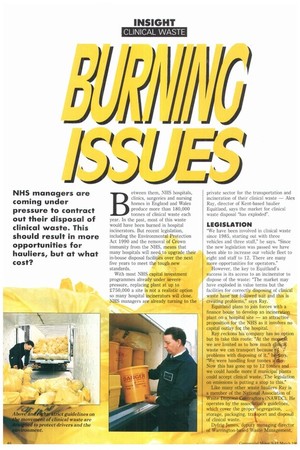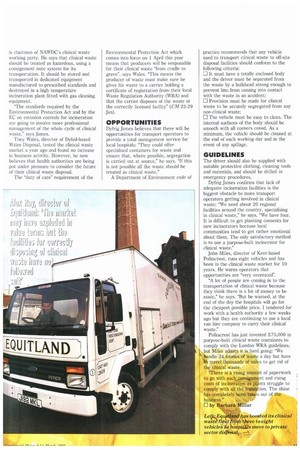./Jrlti.) 1 11)Yo'
Page 42

Page 43

If you've noticed an error in this article please click here to report it so we can fix it.
NHS managers are coming under pressure to contract out their disposal of clinical waste. This should result in more opportunities for hauliers, but at what cost?
etween them, NHS hospitals, clinics, surgeries and nursing homes in England and Wales produce more than 180,000 tonnes of clinical waste each year. In the past, most of this waste would have been burned in hospital incinerators. But recent legislation, including the Environmental Protection Act 1990 and the removal of Crown immunity from the NHS, means that many hospitals will need to upgrade their in-house disposal facilities over the next five years to meet the tough new standards.
With most NHS capital investment programmes already under severe pressure, replacing plant at up to £750,000 a site is not a realistic option so many hospital incinerators will close. NHS managers are already turning to the private sector for the transportation and incineration of their clinical waste — Alex Ray, director of Kent-based haulier Equitland, says the market for clinical waste disposal "has exploded".
LEGISLATION
We have been involved in clinical waste since 1985, starting out with three vehicles and three staff," he says. "Since the new legislation was passed we have been able to increase our vehicle fleet to eight and staff to 12. There are many more opportunities for operators."
However, the key to Equitland's success is its access to an incinerator to dispose of the waste: "The market may have exploded in value terms but the facilities for correctly disposing of clinical waste have not followed suit and this is creating problems," says Ray.
Equitland plans to join forces with a finance house to develop an incineration.. plant on a hospital site — an attractive proposition for the NHS as it involves no capital outlay fox the hospital.
Ray reckons his company has no option but to take this route: "At the mo we are limited as to how much 4i waste we can transport because problems with disposing of it," h "We were handling four tonnes y. Now this has gone up to 12 tonnes and we could handle more if municipal plants could accept clinical waste. The legislation on emissions is putting a stop to this."
Like many other waste hauliers Ray is a member of the N 'onal Association of 1717-a-4eors, (NAWDC). He
operates by the asso ''s guidelines, which cover the prope segregation, storage, packaging, trarport and disposal of clinical waste.
Dyfrig James, deputy managing director of Warrington-baSed Waste Management, is chairman of NAWDC's clinical waste working party. He says that clinical waste should be treated as hazardous, using a consignment note system for its transportation. It should be stored and transported in dedicated equipment manufactured to prescribed standards and destroyed in a high temperature incineration plant fitted with gas cleaning equipment.
"The standards required by the Environmental Protection Act and by the EC on emission controls for incineration are going to involve more professional management of the whole cycle of clinical waste," says James.
Tony Wales, director of Dyfed-based Wales Disposal, tested the clinical waste market a year ago and found no increase in business activity. However, he now believes that health authorities are being put under pressure to consider the future of their clinical waste disposal.
The "duty of care" requirement of the
Environmental Protection Act which comes into force on 1 April this year means that producers will be responsible for their clinical waste "from cradle to grave", says Wales. "This means the producer of waste must make sure he gives his waste to a carrier holding a certificate of registration from their local Waste Regulation Authority (WRA) and that the carrier disposes of the waste at the correctly licensed facility" (CM 23-29 Jan).
OPPORTUNITIES
Dying James believes that there will be opportunities for transport operators to provide a total management service for local hospitals: "They could offer specialised containers for waste and ensure that, where possible, segregation is carried out at source," he says. "if this is not possible all the waste should be treated as clinical waste."
A Department of Environment code of practice recommends that any vehicle used to transport clinical waste to off-site disposal facilities should conform to the following criteria: O It must have a totally enclosed body and the driver must be separated from the waste by a bulkhead strong enough to prevent him from coming into contact with the waste in an accident; D Provision must be made for clinical waste to be securely segregated from any non-clinical waste; O The vehicle must be easy to clean. The internal surfaces of the body should be smooth with all corners coved. As a minimum, the vehicle should be cleaned at the end of each working day and in the event of any spillage.
GUIDELINES
The driver should also be supplied with suitable protective clothing, cleaning tools and materials, and should be drilled in emergency procedures.
Dyfrig James confirms that lack of adequate incineration facilities is the biggest obstacle to more transport operators getting involved in clinical waste: "We need about 20 regional facilities around the country, specialising in clinical waste," he says. "We have four. It is difficult to get planning consents for new incinerators because local communities tend to get rather emotional about them. The only satisfactory method is to use a purpose-built incinerator for clinical waste."
John Miles, director of Kent-based Polkacrest, runs eight vehicles and has been in the clinical waste market for 10 years. He warns operators that opportunities are "very overrated".
"A lot of people are coming in to the transportation of clinical waste because they think there is a lot of money to be made," he says. "But be warned, at the end of the day the hospitals will go for the cheapest possible price. I tendered for work with a health authority a few weeks ago but they are continuing to use a local van hire company to carry their clinical waste."
Polkacrest has just invested £75,000 in purpose-built clinical waste containers to comply with the London WRA guidelines, but Miles admits it is hard going: "We !iiandle 24 tonnes of waste a day but have % travel thousands of miles to get rid of the clinical waste.
"There is a rising amount of paperwork to go with each consignment and rising costs of incineration as r4nts struggle to comply with all the legistion. The shine has completely been taken out of the business." \ 0 by Barbara Millar












































































































